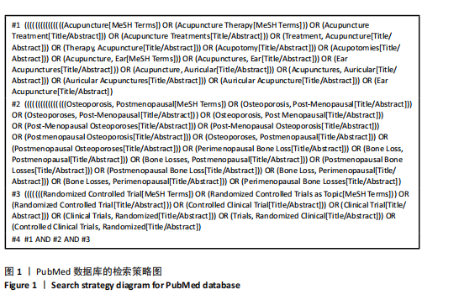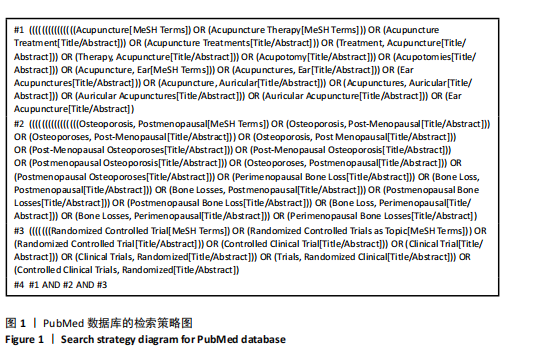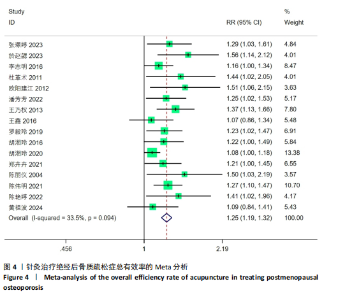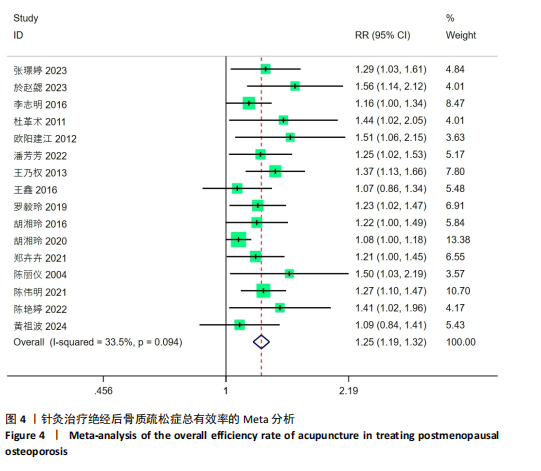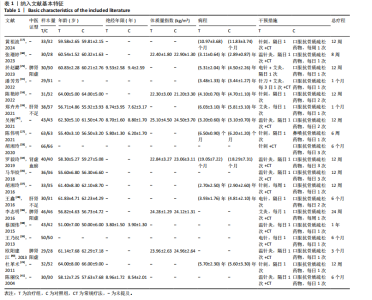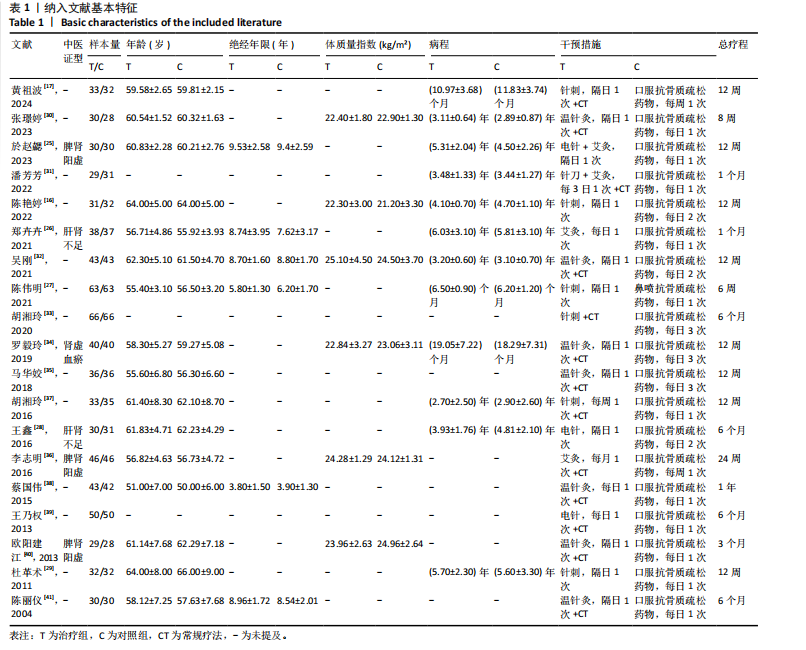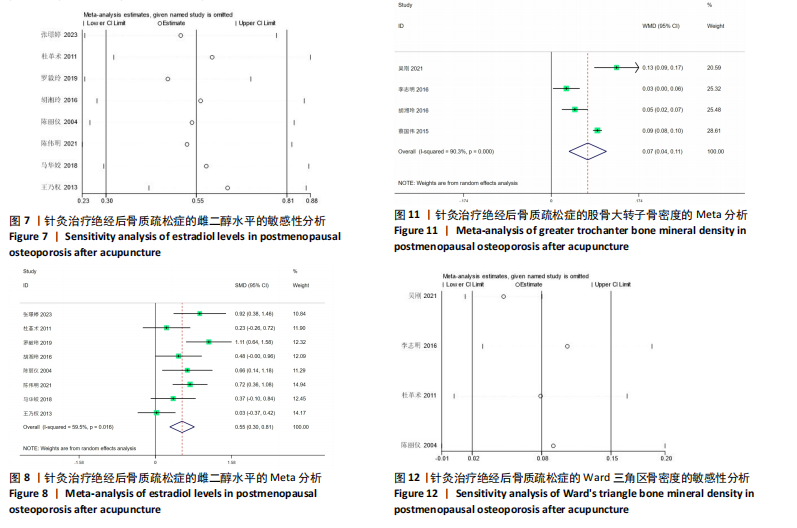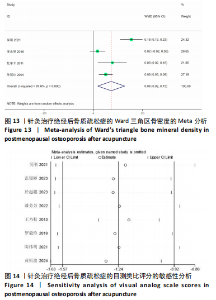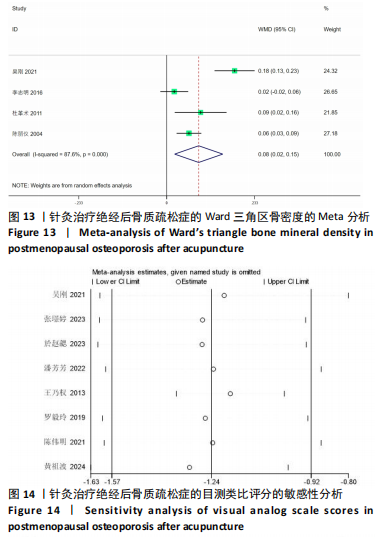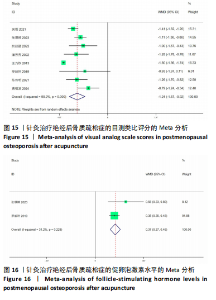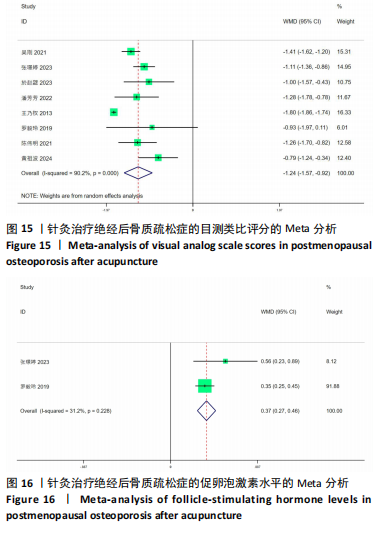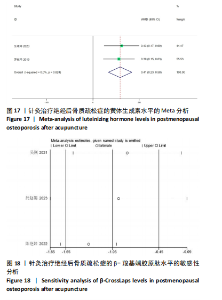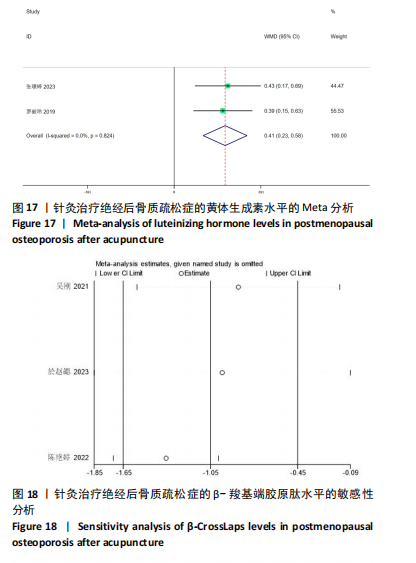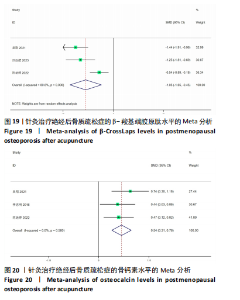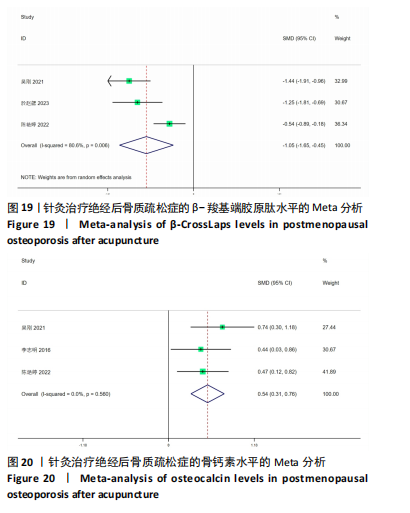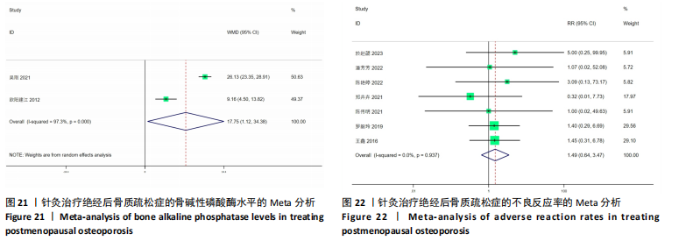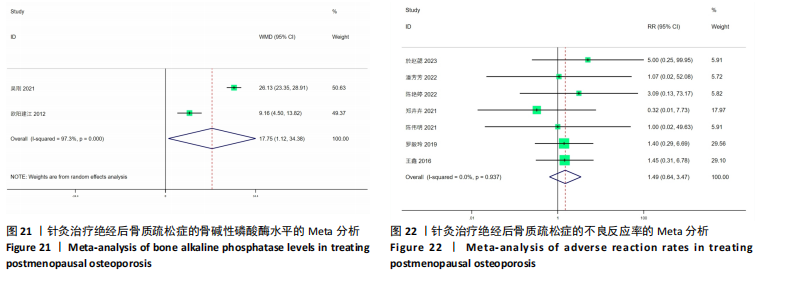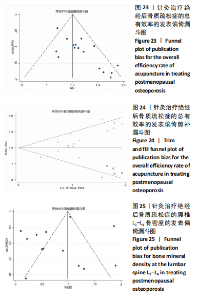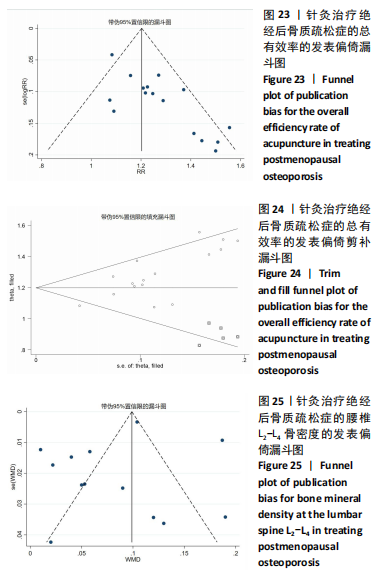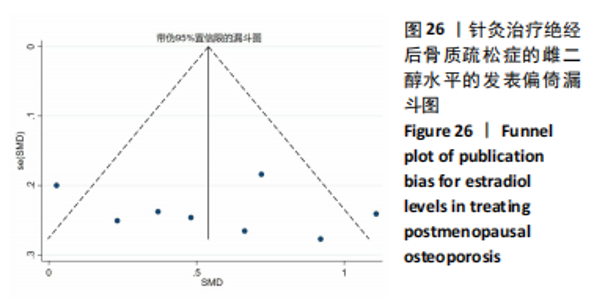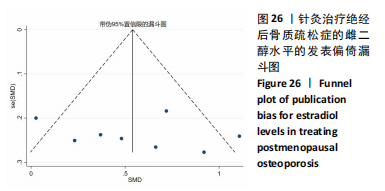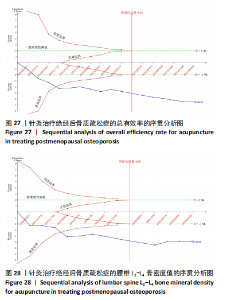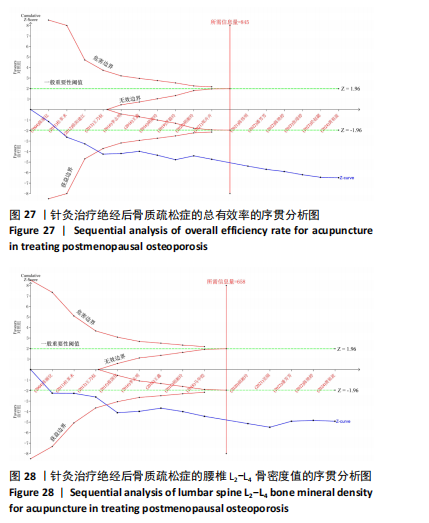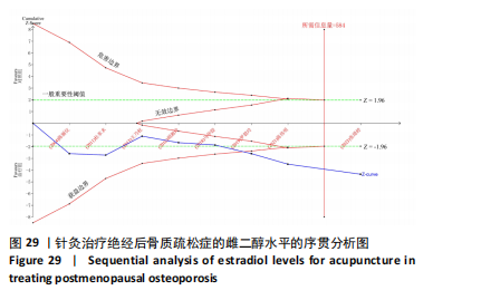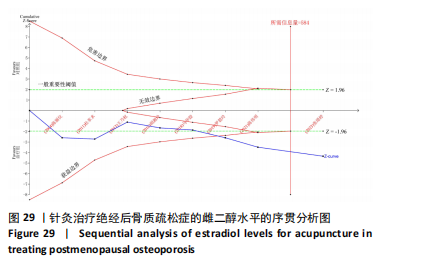Chinese Journal of Tissue Engineering Research ›› 2025, Vol. 29 ›› Issue (29): 6305-6316.doi: 10.12307/2025.763
Previous Articles Next Articles
Acupuncture for treatment of postmenopausal osteoporosis: meta-analysis, systematic evaluation and trial sequential analysis
Yu Bingbing1, 2, Wang Tingting3, Fang Junlin1, 2, Guo Yun2, Huang Yingru1
- 1School of Traditional Chinese Medicine, Chongqing Medical University, Chongqing 400016, China; 2Department of Orthopedics, Tongliang District Hospital of Traditional Chinese Medicine Affiliated to Chongqing Medical University, Chongqing 402560, China; 3School of Nursing, Chongqing Medical University, Chongqing 400016, China
-
Received:2024-08-19Accepted:2024-10-08Online:2025-10-18Published:2025-03-08 -
Contact:Huang Yingru, MD, Professor, Doctoral supervisor, School of Traditional Chinese Medicine, Chongqing Medical University, Chongqing 400016, China -
About author:Yu Bingbing, Master’s candidate, School of Traditional Chinese Medicine, Chongqing Medical University, Chongqing 400016, China; Department of Orthopedics, Tongliang District Hospital of Traditional Chinese Medicine Affiliated to Chongqing Medical University, Chongqing 402560, China -
Supported by:National Natural Science Foundation of China (General Program), No. 81674002 (to HYR); National Grassroots Famous Traditional Chinese Medicine Inheritance Studio Construction Project of the National Administration of Traditional Chinese Medicine, No. [2018]133 (to GY [project participant]); Chongqing Science and Health Joint Traditional Chinese Medicine Research Project, No. 2023MSXM184 (to GY [project participant]); The Fourth Batch of National Traditional Chinese Medicine (Clinical, Basic) Excellent Talent Training Project, No. [2017]24 (to GY)
CLC Number:
Cite this article
Yu Bingbing, Wang Tingting, Fang Junlin, Guo Yun, Huang Yingru. Acupuncture for treatment of postmenopausal osteoporosis: meta-analysis, systematic evaluation and trial sequential analysis[J]. Chinese Journal of Tissue Engineering Research, 2025, 29(29): 6305-6316.
share this article
Add to citation manager EndNote|Reference Manager|ProCite|BibTeX|RefWorks
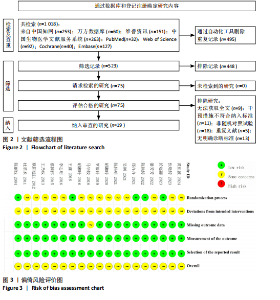
3项常规针刺[16,27,29]、1项艾灸[26]、1项电针+艾灸[25]、1项电针[28];而联合常规疗法的研究包括7项温针灸[30,32,34-35,38,40-41]、3项常规针 刺[17,33,37]、1项针刀+艾灸[31]、1项艾灸[36]、1项电针[39]。单组样本量范围为28-66例,患者平均年龄为50-66岁,平均绝经年限为4-10年,体质量指数为21.20-25.10 kg/m2,治疗频率为每月1次到每天1次不等,总疗程时间为1个月至1年。详细信息见表1。 2.3 偏倚风险评估 关于随机化序列生成的偏倚,12项研究采用随机数表法被归入低风险[16-17,25-28,30,32,34,37-38,41];7项研究因随机序列生成信息的缺失导致其随机偏差风险无法准确评估[29,31,33,35-36,39-40],被归类为不明确风险。关于分配隐藏,5项研究采用信封法[16,25-26,28,41],评定为低风险;其余研究均未说明有关分配隐藏的细节,归类为不明确风险。在盲法方面,3项研究采用单盲设计[16,25-26],故在患者及操作者的盲法方面归为高风险,而对于结果评价员的盲法则归为低风险;其余研究的报告均缺乏有关盲法具体细节,评定为不明确风险。关于完整的结果数据,所有研究均完整汇报了数据,认定为低风险。在报告偏倚方面,1项研究出现脱落病例且未说明理由[37],归类为高风险;1项研究未报告脱落病例的详细细节[35],归类为不明确风险;7项研究报告了脱落病例及脱落理由[16,25-26,28,30-31,40],被评为低风险;其余研究均未出现脱落病例而被评为低风险。最后,在潜在偏倚方面,由于评估所需信息不足,所有研究均被认定为不明确风险。详细信息见图3。 2.4 主要结局 2.4.1 总有效率 16项研究报告了总有效率[16-17,25-31,33-34,36-37,39-41]。异质性检验表明研究间异质性较低(I2=33%,P=0.09)。固定效应模型分析显示,治疗组的总有效率显著优于对照组[RR=1.25,95%CI(1.19,1.32),P < 0.001],见图4。 亚组分析显示,当体质量指数> 23.9 kg/m2时,治疗组提高PMOP总有效率的效果与对照组无显著性差异[RR=1.27,95%CI(0.96,1.68),"
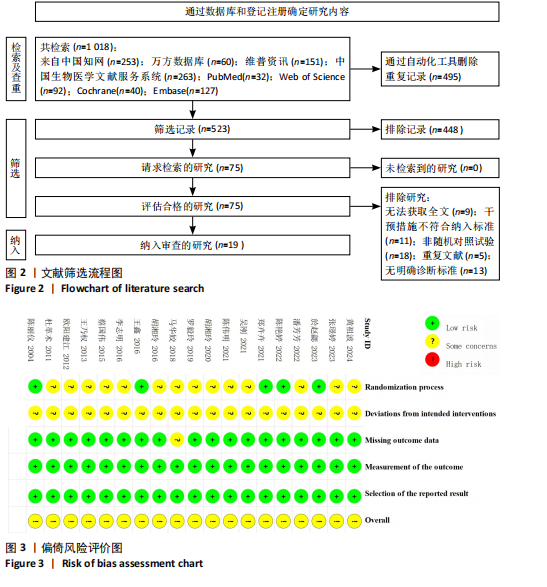
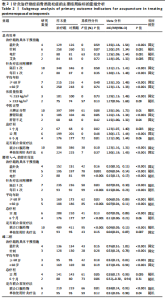
P=0.09);而当体质量指数≤23.9 kg/m2时,治疗组提高PMOP总有效率的效果显著优于对照组[RR=1.29,95%CI(1.13,1.48),P < 0.001]。同样的,当总疗程为6个月时,治疗组提高PMOP总有效率的效果与对照组也无显著性差异[RR=1.21,95%CI (1.00,1.44),P=0.06];而当总疗程为1个月或12周时,治疗组提高PMOP总有效率的效果显著优于对照组[1个月:RR=1.23,95%CI(1.07,1.40),P=0.003;12周:RR=1.30,95%CI(1.17,1.44),P < 0.001]。此外,治疗组提高PMOP总有效率的效果不受干预措施类别及频率、针灸疗法是否联合常规疗法以及患者的平均年龄、中医证型的影响,均显著优于对照组,见表2。 2.4.2 腰椎L2-L4的骨密度值 13项研究报告了腰椎L2-L4的骨密度值[16-17,28-29,31-33,35-39,41]。异质性分析显示研究间的异质性较高(I2=94%,P < 0.001)。敏感性分析显示合并结果有较高的稳健性且研究间的高异质性无显著性改变。随机效应模型分析显示,治疗组在提升腰椎L2-L4骨密度值方面的效果显著优于对照组[MD=0.08,95%CI(0.05,0.11),P < 0.001],见图5,6。 亚组分析显示,当总疗程为12周时,治疗组提高PMOP患者腰椎L2-L4骨密度值的效果显著优于对照组[MD=0.07,95%CI(0.05,0.09),P < 0.001];而总疗程为6个月时,两组PMOP患者腰椎L2-L4骨密度值无显著性差异[MD=0.11,95%CI(0.00,0.21),P=0.06]。此外,治疗组提高腰椎L2-L4骨密度值的效果不受干预措施的类别与频率、针灸疗法是否联合常规疗法以及患者平均年龄的影响,均显著优于对照组,见表2。 2.4.3 雌二醇水平 8项研究报告了雌二醇水平[27,29-30,34-35,37,39,41]。由于统计单位存在差异,故选用SMD作为统一的效应量衡量指标。异质性分析显示研究间异质性较高(I2=59%,P=0.02)。敏感性分析显示剔除一项研究后研究间的异质性显著降低(I2=36%,P=0.16)[39],但合并结果仍保持较高的稳健性。随机效应模型分析显示,治疗组在提高雌二醇水平方面显著优于对照组[SMD=0.55,95%CI (0.30, 0.81),P < 0.001],见图7,8。"
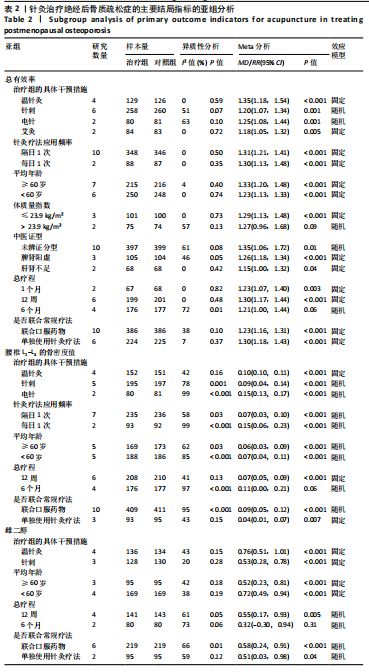
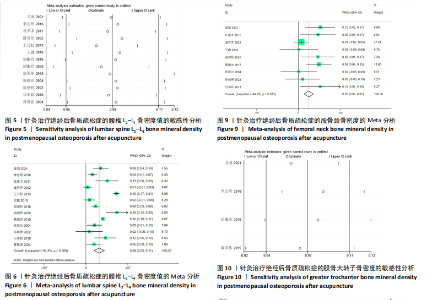
亚组分析显示,当总疗程为12周时,治疗组提高PMOP患者雌二醇水平的效果显著优于对照组[SMD=0.55,95%CI(0.17,0.93),P=0.005];而总疗程为6个月时,两组PMOP患者雌二醇水平无显著性差异[SMD=0.32, 95%CI(-0.30,0.94),P=0.31]。此外,治疗组提高PMOP患者雌二醇水平的效果不受干预措施类别、是否联合常规疗法以及患者年龄的影响,均显著优于对照组,见表2。 2.5 次要结局 2.5.1 股骨颈的骨密度值 9项研究报告了股骨颈的骨密度值[16,28-29,31-33,35,38,41]。异质性分析显示研究间异质性较低(I2=44%,P=0.07)。固定效应模型分析显示,治疗组在提高股骨颈的骨密度方面显著优于对照组[MD=0.05,95%CI(0.03,0.07),P < 0.001],见图9。 2.5.2 股骨大转子的骨密度值 4项研究报告了股骨大转子的骨密度值[32,36-38]。异质性分析显示研究间存在高异质性(I2=90%,P < 0.001)。敏感性分析显示合并结果的稳健性较高且异质性未发生显著性改变。随机效应模型分析显示,治疗组在提高股骨大转子的骨密度方面显著优于对照组[MD=0.07,95%CI(0.04,0.11),P < 0.001]。见图10,11。 2.5.3 Ward三角区的骨密度值 4项研究报告了Ward三角区的骨密度值[29,32,36,41]。异质性分析显示研究间存在高异质性(I2=88%,P < 0.001)。敏感性分析显示合并结果的稳健性较高且异质性未发生显著性改变。随机效应模型分析显示,治疗组在提高Ward三角区的骨密度方面显著优于对照组[MD=0.08,95%CI(0.02,0.15),P=0.009],见图12,13。 2.5.4 目测类比评分 8项研究报告了目测类比评分[17,25,27,30-32,34,39]。异质性分析显示研究间异质性较高(I2=90%,P < 0.001)。敏感性分析显示剔除一项研究后研究间的异质性显著降低(I2=28%,P=0.22)[39],但合并结果仍保持较高的稳健性。随机效应模型分析显示,治疗组在降低目测类比评分方面显著优于对照组[MD=-1.24,95%CI(-1.57,-0.92),P < 0.001],见图14,15。 2.5.5 促性腺激素 (1)促卵泡激素水平:2项研究报告了促卵泡激素水平[30,34]。异质性分析提示研究间异质性较低(I2=31%,P=0.23)。固定效应模型分析显示,治疗组相比对照组可显著提高促卵泡激素水平[MD=0.37,95%CI(0.27,0.46),P < 0.001],见图16。"
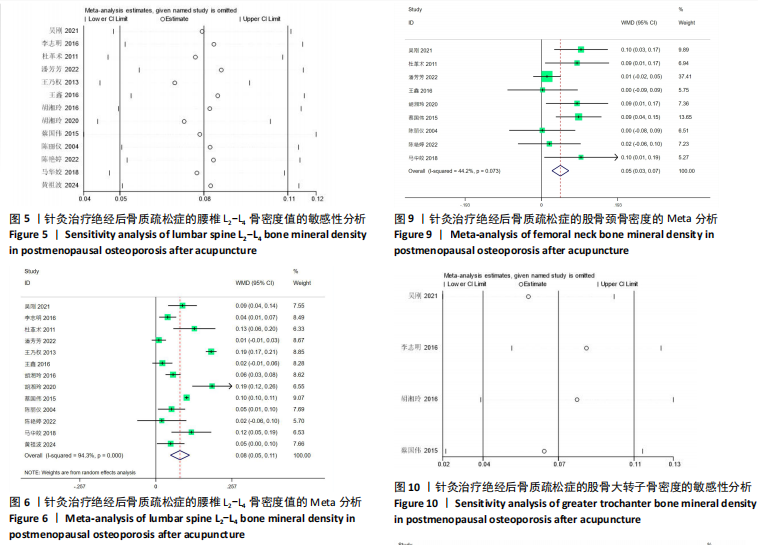
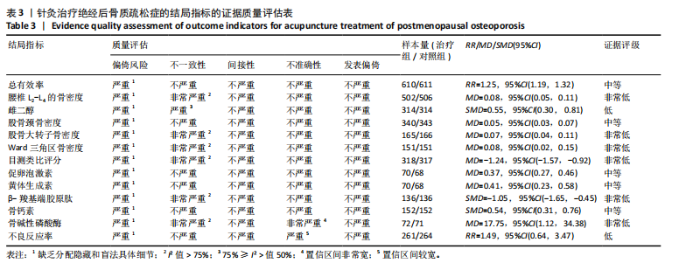
(2)黄体生成素:2项研究报告了黄体生成素水平[30,34]。异质性分析提示研究间存在同质性(I2=0%,P=0.82)。固定效应模型分析显示,治疗组相比对照组可显著提高黄体生成素水平[MD=0.41,95%CI(0.23,0.58),P < 0.001],见图17。 2.5.6 骨代谢指标 (1)β-羧基端胶原肽水平:3项研究报告了β-羧基端胶原肽水平[16,25,32]。由于统计单位存在差异,故选用SMD作为统一的效应量衡量指标。异质性分析提示研究间异质性较高(I2=81%,P=0.006)。敏感性分析显示剔除一项研究后研究间的异质性显著降低(I2=0%,P=0.62)[16],但合并结果仍保持较高的稳健性。随机效应模型分析显示,治疗组相比对照组可显著降低β-羧基端胶原肽水平[SMD=-1.05, 95%CI(-1.65,-0.45),P < 0.001],见图18,19。 (2)骨钙素水平:3项研究报告了骨钙素水平[16,32,36]。由于统计单位存在差异,故选用SMD作为统一的效应量衡量指标。异质性分析提示研究间存在同质性(I2=0%,P=0.56)。固定效应模型分析显示,治疗组相比对照组可显著提高骨钙素水平[SMD=0.54,95%CI(0.31,0.76),P < 0.001],见图20。 (3)骨碱性磷酸酶水平:2项研究报告了骨碱性磷酸酶水平[32,40]。异质性分析显示研究间异质性较高(I2=97%,P < 0.001)。随机效应模型分析显示,治疗组相比对照组可显著提高骨碱性磷酸酶水平[MD=17.75,95%CI(1.12,34.38),P=0.04],见图21。 2.5.7 不良反应率 7项研究报告了不良反应记录[16,25-28,31,34]。由于存在零事件,故采用连续校正(0.5校正)的方法进行处理。异质性分析显示研究间存在同质性(I2=0%,P=0.94)。固定效应模型分析显示,治疗组的不良反应率相较于对照组无显著性差异[RR=1.49,95%CI(0.64,3.47),P=0.36],见图22。 2.6 发表偏倚 对主要结局指标采用漏斗图、Egger检验进行发表偏倚分析,见图23-26。 总有效率的漏斗图显示了明显的不对称性,结合Egger检验结果(t=4.63,P < 0.001),表示总有效率可能存在潜在的发表偏倚。采用剪补法分析,使用Linear经4次迭代后,估计缺失文献5篇,结果显示剪补前[效应量的加权方差(Q)=28.995,P=0.016]、剪补后(Q=45.532,P= 0.002)的异质性均较高,故采用随机效应模型分析,效应指标剪补前[RR=1.25,95%CI(1.18,1.32)]、剪补后[RR=1.20,95%CI(1.13,1.27)]合并结果未发生显著性改变,提示总有效率的高稳健性不受发表偏倚的影响。 在腰椎L2-L4的骨密度值方面,漏斗图的对称性及Egger检验结果(t= -0.94,P=0.368)表明不存在明显发表偏倚。 同样的,雌二醇水平漏斗图的对称性及Egger检验结果(t=0.64,P=0.545)表明不存在明显发表偏倚。 2.7 证据质量评估 The GRADEpro评估显示,中等确定性证据支持针灸疗法相较于常规疗法可显著提高总有效率、股骨颈的骨密度、促卵泡激素水平、黄体生成素水平以及骨钙素水平。低确定性证据支持针灸疗法相较于常规疗法可显著提高雌二醇水平且不显著提高不良反应发生率。其他结局指标均评估为非常低质量证据,见表3。 2.8 试验序贯分析 试验序贯分析显示,总有效率、腰椎L2-L4骨密度值和雌二醇水平的Z曲线均越过了获益边界,并达到了所需的信息量,表明针灸疗法能提高PMOP患者的总有效率、腰椎L2-L4骨密度以及雌二醇水平的结论是确凿的,见图27-29。"
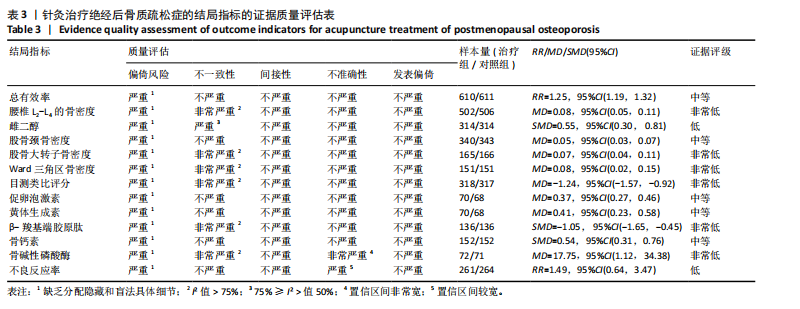
| [1] GREGSON CL, ARMSTRONG DJ, BOWDEN J, et al. UK clinical guideline for the prevention and treatment of osteoporosis. Arch Osteoporos. 2022;17(1):58. [2] Consensus development conference: prophylaxis and treatment of osteoporosis. Osteoporos Int. 1991;1(2):114-117. [3] SALARI N, DARVISHI N, BARTINA Y, et al. Global prevalence of osteoporosis among the world older adults: a comprehensive systematic review and meta-analysis. J Orthop Surg Res. 2021;16(1):669. [4] EASTELL R, O’NEILL TW, HOFBAUER LC, et al. Postmenopausal osteoporosis. Nat Rev Dis Primers. 2016;2:16069. [5] LUPSA BC, INSOGNA K. Bone Health and Osteoporosis. Endocrinol Metab Clin North Am. 2015;44(3):517-530. [6] 何海洋,杨嘉玲,雷迅.绝经后女性骨质疏松症患病率及影响因素的Meta分析[J].中国全科医学,2024,27(11):1370-1379. [7] 吴惠一,刘颖,兰亚佳,等.中国绝经女性骨质疏松症患病率的Meta分析[J].中国循证医学杂志,2022,22(8):882-890. [8] 张智海,刘忠厚,石少辉,等.中国大陆地区以-2.5SD为诊断的骨质疏松症发病率文献回顾性研究[J].中国骨质疏松杂志,2015,21(1):1-7+24. [9] SHEN Y, HUANG X, WU J, et al. The Global Burden of Osteoporosis, Low Bone Mass, and Its Related Fracture in 204 Countries and Territories, 1990-2019. Front Endocrinol (Lausanne). 2022;13:882241. [10] LEBOFF MS, GREENSPAN SL, INSOGNA KL, et al. The clinician’s guide to prevention and treatment of osteoporosis. Osteoporos Int. 2022;33(10):2049-2102. [11] MANOLAGAS SC. From estrogen-centric to aging and oxidative stress: a revised perspective of the pathogenesis of osteoporosis. Endocr Rev. 2010;31(3):266-300. [12] LU L, TIAN L. Postmenopausal osteoporosis coexisting with sarcopenia: the role and mechanisms of estrogen. J Endocrinol. 2023;259(1):e230116. [13] 王建华.骨质疏松症治疗药物的分类与用药选择[J].中华老年骨科与康复电子杂志,2019,5(5):297-300. [14] PING R, QUANWU W, WEI B, et al. Identifying the effective combination of acupuncture and traditional Chinese medicinal herbs for postmenopausal osteoporosis therapy through studies of their molecular regulation of bone homeostasis. J Tradit Chin Med. 2024; 44(1):212-219. [15] 郭迪,高志攀,张亚平,等.针刺通过Wnt信号通路对绝经后骨质疏松骨折大鼠骨密度和骨代谢的作用研究[J].中国骨质疏松杂志,2023,29(3):349-355+384. [16] 陈艳婷,林丽梅,王晓东,等.岭南陈氏针法治疗绝经后骨质疏松症及对血清GH、IGF-1的影响[J].中国针灸,2022, 42(9):979-984. [17] 黄祖波,曾月,周浩,等.针药结合对绝经后骨质疏松患者腰腿疼痛的疗效评价研究[J].四川中医,2024,42(3):188-190. [18] PAGE MJ, MCKENZIE JE, BOSSUYT PM, et al. The PRISMA 2020 statement: an updated guideline for reporting systematic reviews. BMJ. 2021;372:n71. [19] 中华医学会骨质疏松和骨矿盐疾病分会.原发性骨质疏松症诊疗指南(2022)[J].中华骨质疏松和骨矿盐疾病杂志,2022, 15(6):573-611. [20] 中华中医药学会.绝经后骨质疏松症(骨痿)中医药诊疗指南(2019年版)[J].中医正骨,2020,32(2):1-13. [21] 《骨科疾病疗效评价标准》出版[J].实用骨科杂志,2012,18(8):691. [22] 王瑞平.随机对照临床试验设计中的样本量估算方法[J].上海医药,2023,44(1): 48-52. [23] HIGGINS J, GREEN S. “Cochrane Handbook for Systematic Reviews of Interventions Version 5.1.0,” in The Cochrane Collaboration[2024-08-18]. http://www.cochrane-handbook.org. [24] STERNE JA, SUTTON AJ, IOANNIDIS JP, et al. Recommendations for examining and interpreting funnel plot asymmetry in meta-analyses of randomised controlled trials. BMJ. 2011;343:d4002. [25] 於赵勰.电针联合温和灸治疗脾肾阳虚型绝经后骨质疏松症的临床研究[D].武汉:湖北中医药大学,2023. [26] 郑卉卉.艾灸热敏化腧穴治疗肝肾不足型绝经后骨质疏松症腰背疼痛的临床研究[D].兰州:甘肃中医药大学,2021. [27] 陈伟明,廖垚,鲍广兵,等.《内经》傍针刺法配合鲑鱼降钙素治疗绝经后骨质疏松症的临床研究[J].按摩与康复医学, 2021,12(19):13-15. [28] 王鑫.电针治疗肝肾不足型绝经后骨质疏松症的临床观察[D].福州:福建中医药大学,2016. [29] 杜革术.针刺对绝经后骨质疏松患者骨密度及血清雌二醇的影响[J].上海针灸杂志,2011,30(2):104-106. [30] 张璟婷,薄化君,陈柯村.温针灸肾俞穴治疗绝经后骨质疏松症的疗效观察[J].新疆医科大学学报,2023,46(7):961-965. [31] 潘芳芳,任叔舆,吴萍,等.微针刀联合温和灸治疗绝经后骨质疏松症的疗效观察[J].浙江临床医学,2022,24(12):1790-1791+1794. [32] 吴刚,张永锋.温针灸加补肾通络方对绝经后骨质疏松症患者骨代谢及疼痛的影响[J].检验医学与临床,2021,18(21):3172-3175. [33] 胡湘玲,何年红,尹书东,等.针灸联合补骨丸治疗绝经后骨质疏松症临床研究[J].云南中医中药杂志,2020,41(9):53-55. [34] 罗毅玲,周丕琪,王刚.温针灸联合古方青娥丸加味对绝经后骨质疏松腰腿痛患者疼痛、氧化应激及性激素水平的影响[J].湖南中医药大学学报,2019,39(8): 977-981. [35] 马华姣,郑进福,陈俊辉.温针灸治疗绝经后骨质疏松症效果分析[J].深圳中西医结合杂志,2018,28(20):42-43. [36] 李志明,杨冬,马锌明.督灸联合阿仑膦酸钠肠溶片治疗绝经后骨质疏松症(脾肾阳虚证)的疗效观察[J].中医药导报,2016,22(1):61-63. [37] 胡湘玲.针刺对绝经后骨质疏松患者骨密度及血清雌二醇的影响[J].湖南中医杂志,2016,32(11):86-87. [38] 蔡国伟,李静,薛远志,等.温针灸配合元素钙防治绝经后骨质丢失临床研究[J].中国针灸,2015,35(9):881-884. [39] 王乃权,周志华,潘芳芳,等.针药结合治疗绝经后骨质疏松症的临床研究[J].中国中医药科技,2013,20(1):6-7. [40] 欧阳建江,许辛寅.温和灸对肾阳虚型绝经后骨质疏松症患者红外热皮温值及骨转换指标的影响[J].辽宁中医药大学学报,2013,15(1):152-154. [41] 陈丽仪,郭元琦,凌楠.温针对绝经后骨质疏松症骨密度的影响及疗效研究[J].中国针灸,2004,24(11):744-746. [42] FINTINI D, CIANFARANI S, COFINI M, et al. The Bones of Children With Obesity. Front Endocrinol (Lausanne). 2020;11:200. [43] MA X, GUO Z, GAO W, et al. LncRNA-NEF is downregulated in postmenopausal osteoporosis and is related to course of treatment and recurrence. J Int Med Res. 2019;47(7):3299-3306. [44] 肖丽,陈果,龙抗胜,等.针灸治疗绝经后骨质疏松症疗效及选穴规律的meta分析[J].湘南学院学报(医学版),2016, 18(4):12-15. [45] 李胜,张丰正,王鸿度,等.针灸治疗绝经后骨质疏松症临床文献的系统评价[J].泸州医学院学报,2014,37(5):461-467. |
| [1] | Zhang Xinxin, Gao Ke, Xie Shidong, Tuo Haowen, Jing Feiyue, Liu Weiguo. Network meta-analysis of non-surgical treatments for foot and ankle ability and dynamic balance in patients with chronic ankle instability [J]. Chinese Journal of Tissue Engineering Research, 2025, 29(9): 1931-1944. |
| [2] | Sun Yundi, Cheng Lulu, Wan Haili, Chang Ying, Xiong Wenjuan, Xia Yuan. Effect of neuromuscular exercise for knee osteoarthritis pain and function: a meta-analysis [J]. Chinese Journal of Tissue Engineering Research, 2025, 29(9): 1945-1952. |
| [3] | Wang Yida, Liu Jun, Wang Xiaoling, Wang Liyan, Yang Chengru, Zhang Xuexiao. Effects of wearable electronic device-based interventions on physical activity and sedentary behavior in healthy adolescents: a meta-analysis [J]. Chinese Journal of Tissue Engineering Research, 2025, 29(8): 1693-1704. |
| [4] | Zhang Zixian, Xu Youliang, Wu Shaokui, Wang Xiangying. Effects of blood flow restriction training combined with resistance training on muscle indicators in college athletes: a meta-analysis [J]. Chinese Journal of Tissue Engineering Research, 2025, 29(8): 1705-1713. |
| [5] | Wang Juan, Wang Guanglan, Zuo Huiwu. Efficacy of exercise therapy in the treatment of anterior cruciate ligament reconstruction patients: #br# a network meta-analysis #br# [J]. Chinese Journal of Tissue Engineering Research, 2025, 29(8): 1714-1726. |
| [6] | Zheng Huakun, Yin Mingyue, Liu Qian. Effects of interval and continuous training on the quality of life in physically inactive adults: a meta-analysis [J]. Chinese Journal of Tissue Engineering Research, 2025, 29(8): 1727-1740. |
| [7] |
Huang Xiaobin, Ge Jirong, Li Shengqiang, Xie Lihua, Huang Jingwen, He Yanyan, Xue Lipeng.
Mechanisms of different yin nourishing and kidney tonifying methods on osteoclastysis pathway in ovariectomized rats #br#
#br#
[J]. Chinese Journal of Tissue Engineering Research, 2025, 29(6): 1214-1219.
|
| [8] | Li Zhe, Li Ping, Zhang Chao, Guo Guangling. A network meta-analysis of efficacy of mesenchymal stem cells from different sources in treatment of premature ovarian failure animal models [J]. Chinese Journal of Tissue Engineering Research, 2025, 29(36): 7898-7908. |
| [9] | Wang Kaigang, Hao Dongsheng, Ma Pei, Zhou Shuo, Li Ruimin. Comparison of efficacy of different biological scaffolds for pulp regeneration therapy in immature permanent teeth: a Bayesian network meta-analysis [J]. Chinese Journal of Tissue Engineering Research, 2025, 29(34): 7447-7460. |
| [10] | Wang He, Yu Shaohong, . Meta-analysis of transcranial direct current stimulation in improving lower limb motor dysfunction in stroke patients [J]. Chinese Journal of Tissue Engineering Research, 2025, 29(30): 6556-6565. |
| [11] | Liu Liguo, Qiu Mingwang, Huang Yanling, Fan Zhiyong, Wu Shan, Guo Rusong. Reporting quality of randomized controlled trials on acupuncture and manipulation for greater occipital neuralgia evaluated using the CONSORT statement and STRICTA checklist [J]. Chinese Journal of Tissue Engineering Research, 2025, 29(30): 6566-6573. |
| [12] | Wang Jianlei, He Peiliang, Sun Yongjian. A meta-analysis of clinical efficacy and safety of intravenous glucocorticoids before lower limb joint arthroplasty [J]. Chinese Journal of Tissue Engineering Research, 2025, 29(3): 599-607. |
| [13] | Li Jia, Liu Qianru, Xing Mengnan, Chen Bo, Jiao Wei, Meng Zhaoxiang. A network meta-analysis on therapeutic effect of different types of exercise on knee osteoarthritis patients [J]. Chinese Journal of Tissue Engineering Research, 2025, 29(3): 609-616. |
| [14] | Zhou Yanjie, Cao Chunfeng, Zhang Zhongzu, Niu Xiong, Wang Xin, Yang Zaihai, Zhou Liang, Li Bo. Meta-analysis of anterior cervical decompression and fusion ROI-CTM self-locking system in treatment of degenerative cervical spondylosis [J]. Chinese Journal of Tissue Engineering Research, 2025, 29(3): 617-627. |
| [15] | Jiang Siqi, Huang Huanhuan, Yu Xinyu, Peng Ying, Zhou Wei, Zhao Qinghua. Meta-analysis of dose-effect of exercise on improving muscle health in community-dwelling older adults with sarcopenia [J]. Chinese Journal of Tissue Engineering Research, 2025, 29(29): 6295-6304. |
| Viewed | ||||||
|
Full text |
|
|||||
|
Abstract |
|
|||||
